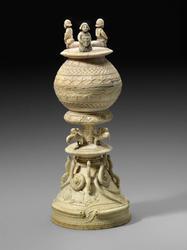Advanced Search 
Three men kneel atop this ivory saltcellar, a luxurious souvenir brought to Lisbon from the coast of West Africa by Portuguese traders. Salt was an expensive commodity in this period—placing salt in an elaborate saltcellar made its presence on the table more conspicuous to guests. More than fifty West African saltcellars (or sections of them) have survived to the present, usually in what were called the "curiosity cabinets" of European royal households. It is unlikely that this saltcellar was heavily used, based on the condition of the interior of the globe where salt would have been stored.
Some elements of this saltcellar represent the client, likely a Portuguese merchant, while others were added by the artist who worked on the Guinea coast. The kneeling figures in Portuguese tunics, the hunting scene on the base, the oak-leaf pattern, and the form of the saltcellar itself would have been shown to the artist on playing cards or etchings supplied by his client. The curling snakes, prominent birds, interlace pattern, and bands of small, inset spheres were likely part of a longer Sapes (sometimes written as Sapi) tradition. The identity of the Sapes artist and the specifics of his training are unknown, but new research demonstrates that a bustling market in spoons, saltcellars, and other ivory works existed in what is now Sierra Leone through the seventeenth century. Such items were made for sailors as well as for a cosmopolitan local market of European settlers fleeing religious persecution in Portugal.

Thumbnail-size images of copyrighted artworks are displayed under fair use, in accordance with guidelines recommended by the Code of Best Practices in Fair Use for the Visual Arts, published by the College Art Association in February 2015.
Saltcellar
Sapes (formerly Sapi), Sierra Leone and Guinea
late 15th–early 16th century
Medium/Technique
Ivory
Dimensions
Height x width: 10 x 4 in. (25.4 x 10.2 cm)
Credit Line
Robert Owen Lehman Collection
Accession NumberL-G 7.18.2012
CollectionsAfrica and Oceania
ClassificationsDecorative arts
Three men kneel atop this ivory saltcellar, a luxurious souvenir brought to Lisbon from the coast of West Africa by Portuguese traders. Salt was an expensive commodity in this period—placing salt in an elaborate saltcellar made its presence on the table more conspicuous to guests. More than fifty West African saltcellars (or sections of them) have survived to the present, usually in what were called the "curiosity cabinets" of European royal households. It is unlikely that this saltcellar was heavily used, based on the condition of the interior of the globe where salt would have been stored.
Some elements of this saltcellar represent the client, likely a Portuguese merchant, while others were added by the artist who worked on the Guinea coast. The kneeling figures in Portuguese tunics, the hunting scene on the base, the oak-leaf pattern, and the form of the saltcellar itself would have been shown to the artist on playing cards or etchings supplied by his client. The curling snakes, prominent birds, interlace pattern, and bands of small, inset spheres were likely part of a longer Sapes (sometimes written as Sapi) tradition. The identity of the Sapes artist and the specifics of his training are unknown, but new research demonstrates that a bustling market in spoons, saltcellars, and other ivory works existed in what is now Sierra Leone through the seventeenth century. Such items were made for sailors as well as for a cosmopolitan local market of European settlers fleeing religious persecution in Portugal.
ProvenanceJuly 8, 1974, anonymous (“various properties”) sale, Sotheby’s, London, lot 84, sold for £6000 to Robinson. 2012, promised gift of Robert Owen Lehman to the MFA.
